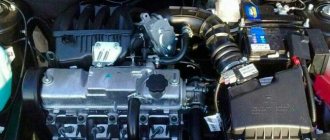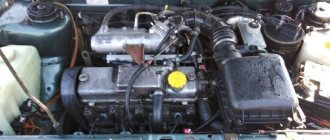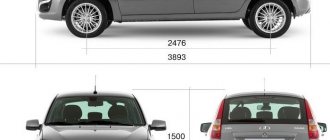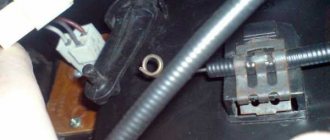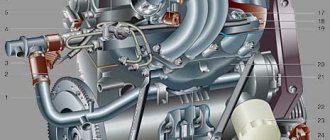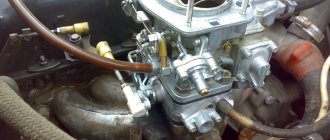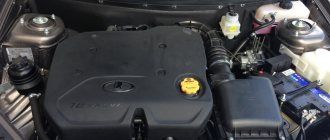The VAZ-2114 first entered mass production in 2003, and received the code name “Samara-2”. This is a restyled version of the VAZ-2109 car, qualitatively improved and modernized. 8-valve and 16-valve VAZ 2114 models were released. Each of them differs in design features and, as a result, technical characteristics.
VAZ 2114
Differences between VAZ 2114 and VAZ 2109
The improvements of the VAZ 2114 in comparison with the prototype turned out to be more than serious. They affected both the appearance and the technical part of the car.
2114 designers made a number of changes:
- new front and rear bumpers installed;
- updated version of the hood;
- the model received improved optics;
- the radiator was lined;
- added a package of moldings.
The interior of the car has changed even more. The instrument panel and steering wheel were completely replaced. To improve passenger and driver comfort, engineers replaced the outdated heater. The 2114 also received new front windshield wipers.
Wiring
As soon as the engine from Priora is installed on the VAZ 2114, it is time for wiring. There will be a lot of work here, “examining” your fine motor skills and nervous system, but there is no need to physically strain yourself anymore. The algorithm is as follows:
- Ignition - we leave the original VAZ 2114 coil, but we change the cover and armored wires to 2112. By the way, you will also have to fiddle with the coil, there is not enough space - you will have to redo the mount.
- We add 40 cm of length in the wires: injector control, phase sensor and oil sensor.
- Everything else connects as needed, including the ECU.
Engine VAZ 2114
The most anticipated changes to the VAZ 2109 concerned the power plant. In the first generation, the model used an 8-valve engine 2114. It had a displacement of 1.5 liters. In the next update of the VAZ 2114, which occurred in 2007, this engine was replaced with an improved one with a volume of 1.6 liters.
The installation of a 16-valve engine on the VAZ 2114 was a real breakthrough for the model. This modernization was carried out entirely under the control of Super-Avto CJSC, part of AvtoVAZ OJSC. The most important characteristic of the 16 valve VAZ 2114 is the maximum power of 89 hp. Thus, the car is technically very close to foreign-made budget cars.
For comparison, we suggest you consider the following table of dynamic indicators:
| LADA 2114 8V | LADA 2114 16V | |
| Maximum power, kW/rpm/hp | 59,5/5200/81 | 66/5000/89 |
| Maximum torque, Nm at rpm | 120/2700 | 131/3700 |
| Fuel consumption in mixed mode, l/100km | 7,6 | 7,0 |
| Maximum speed, km/h | 160 | 190 |
| Acceleration to 100 km/h, s | 13,2 | 11,2 |
Description
Engine 21124 – power and dynamics
The VAZ 124 engine was developed on the basis of a previously developed unit for the 2112 model. The main requirements for the new unit include increasing the safety indicator of the ShPG design, as well as increasing the current volume of the combustion chambers. The manufacturing plant's engineers have provided new, deeper holes that do not interfere with the operation of the valve mechanisms in the event that the gas distribution mechanism drive ruptures. In parallel with this, the 124 engine also has slightly increased cylinder heights, as well as piston stroke.
Unit specifications
Increasing the power of the equipment was not a priority; it was more important to increase the current environmental standard and eliminate possible malfunctions of components and systems. The equipment layout remains unchanged. The following characteristics should be highlighted:
— The internal combustion engine has 16 valves. — At the factory, in comparison with the basic configuration, the engine volume of the VAZ 21124 was increased, which was now 1.6 liters. The power is 89.1 horsepower, while the torque has decreased slightly, now it is 131 rpm. — Manufacturers successfully completed the task, the standard rose to the Euro-4 level, which brought the vehicle on par with many foreign developments. — The diameter of the cylinders is 82 millimeters. — Some adjustments affected the design of the upper camshafts, and the timing belt drive also became new.
The engine is installed on Priora vehicles, VAZ 2112, 2011, 2010 and the fourteenth model from the LADA Samara series.
Design features
The new unit provides a combination of standard solutions from the AvtoVAZ manufacturer and innovative solutions: - A large height of the cylinder block is provided, now this figure is set at 197.1 millimeters. — New threaded holes have been designed; in accordance with standardization, they are marked M10. — Changes have affected the installation method of oil nozzles used to cool piston units. — The engineers used a proven crankshaft from modification 11183. Thanks to this, you can buy a partially unified VAZ 21124 16-valve engine, you can partially replace elements by selecting parts from other AvtoVAZ car models from the catalog.
Road characteristics of the VAZ 2114
In addition to the fact that a 16-valve engine was installed on the model, the VAZ 2114 was significantly re-equipped to improve road properties. The car's gearbox with a gear ratio of 3.7 received a new package of “closed” bearings, which significantly increased the reliability and performance of the system, in particular the torque of the car.
For the braking system of the 16-valve VAZ 2114, engineers used larger diameter (up to 200) clutch brake discs than in 2109. In addition, the brake cooling system was improved, which made it possible to achieve not only safety, but also reliability.
The designers managed to achieve great success in terms of vehicle stability. This was mainly possible thanks to the installation of high-energy shock absorbers, as well as struts from the 2107 model. This set of procedures led to increased body rigidity, road stability, maneuverability and durability.
Engine dismantling/installation
If you have experience installing an engine from a VAZ 2112, then no questions will arise, because the Priora engine on a VAZ 2114 is installed in exactly the same way.
The algorithm of actions is as follows:
- We remove the ramp with injectors, attachments, receiver and exhaust manifold.
- We install the new engine and connect it to the gearbox. To do this, you need to prepare the box in advance and change the GP and a number of gears in it. In the VAZ 2114 box, the crankcase is much smaller than in the 2112 box, therefore, you will need to struggle a little with connecting the clutch. There are three options for solving the problem: firstly, you can replace the flywheel with the clutch with similar ones from 2108, secondly, you can grind the crankcase, thirdly, take the flywheel and the crown from 2108, grind it and press the crown. The third option is the best, because it facilitates all mechanical articulation.
- The only problem with this option is the difficult and time-consuming replacement of the release bearings.
If you decide in advance to change the gearbox to a similar one from 2110, then this procedure will not cause problems at all. The only thing is that you need to replace the starter with the 2110, they are slightly different. By the way, you can save money if the starter is KATEK - you only have to change the overrunning clutch and head.
Reviews of VAZ 2114
Reviews about the 16 valve VAZ 2114 can be said to be mostly positive. In comparison with the 8-valve version, drivers highlight:
- Reduced fuel consumption;
- Increased power;
- Improved overall dynamics.
On the other hand, let's not hide it and look at the weaknesses of the car. As you know, the 16 valve model never entered mass production, and this led to several negative factors at once.
- Firstly, it is not always possible to obtain good quality assembly, which is carried out at Super-Avto CJSC.
- Secondly, the car is expensive to repair, as some spare parts are difficult to obtain.
Advantages of 16 valve cylinder head
In addition to increased power, the VAZ 2112 16 valve engine has the following advantages: 1) Increased detonation resistance due to changes in the design of the combustion chamber. This advantage is especially important for the quality of our gasoline, which leaves much to be desired at domestic gas stations. In addition, this significantly increases the service life of the power unit without major repairs. 2) Better engine cooling - in an engine with 16 valves, the cooling system works much more efficiently and reliably than in the same power unit, but with only 8 elements. This allows you to increase the service life of the engine, as well as realize its full potential. The distance that the car can travel without stopping increases. 3) Possibility of tuning exhaust manifolds as a result of placement of exhaust tracts on different sides of the engine head
What engines drive the VAZ-2114
"VAZ-2114" was produced from 2001 to 2013. Until 2007, it was equipped with a 1.5 77 hp engine. With. It easily lasted 200 thousand km, but was disappointing with noise, knocking and thermostat failure. In the 2007 models, a 1.6 engine with 81 hp appeared. With. It has more torque, but makes noise like a diesel engine.
Both versions work with a five-speed manual transmission. Sometimes there are cars with a 16-valve 1.6 engine with a capacity of 90 or 98 hp. With. It is one of the best from AvtoVAZ, especially for those who like to tune and modify the engine.
Engine 21126 “Priora” (1.6 l., 16 cl.)
A continuation of the evolution of VAZ 16-valve engines was the engine with index 21126. It is a development of 21124, but with some changes. Among them:
- Lightweight ShPG (connecting rod and piston group);
- Better surface treatment;
- Honing of cylinders with more stringent requirements.
The timing drive is a belt drive with overhead camshafts. But unlike its predecessor, when it breaks, the valve bends. There is a radical solution to this design feature - replacing the pistons. If the engine is of a standard design, then you just need to carefully monitor the condition of the belt. Moreover, the problem with its weakening was solved by installing an automatic tensioner. The type of belt used was also changed.
Typical faults
If you feel a loss of power, then most often the reasons for this are the following phenomena:
- Loss of compression due to a burnt-out cylinder head gasket;
- Wear of the cylinder wall;
- Wear of piston rings;
- Piston burnout.
The result of unstable operation and refusal to start may be a problem with pressure in the fuel system. In addition, such symptoms are caused by sensor malfunctions, air leaks through leaky hoses or their connections, timing problems, or problems with the throttle valve.
If the engine is clearly “troubling”, then, first of all, it is necessary to check the compression readings to eliminate the problem of valve burnout. But more often this is caused by faulty spark plugs or a malfunctioning ignition coil. Sometimes the reason lies in the condition of the injectors, namely in the degree of their contamination.
Floating speed is a completely typical disease of VAZ 16-valve engines. Often, in addition to this, the engine runs unevenly. In this case, first of all, it is necessary to check the mass air flow sensor (MAF). If it is working properly, then most likely the cause is the throttle valve. It is necessary to clean it, and possibly replace its position sensor (TPS). At the same time, you should check the condition of the idle air control (IAC).
This engine was not without its signature headache with the thermostat. It also becomes the reason that the engine cannot warm up to operating temperature. However, if there is severe frost outside, perhaps the old-fashioned method of using cardboard in front of the radiator will help.
Some characteristic problems of other VAZ engines migrated to the 21126 Priora. So, if you detect knocking noises under the hood, you should first check the condition of the hydraulic compensators. Most often, they are the culprits of unpleasant knocking noises. At the same time, knocking noises that are associated with main and connecting rod bearings, as well as pistons, familiar from other VAZ engines, can also occur. This is already a serious malfunction, which is fraught with difficult engine repairs.
Minor problems, such as refusal to start, most often lie in the following malfunctions:
- Starter and battery;
- Ignition coil;
- Candles;
- Fuel pump malfunction;
- Clogged fuel filter;
- Faulty fuel pressure regulator.
Having improved its technical characteristics, the 21126 motor is still slightly inferior to its predecessor 21124 in reliability. Although it cannot be said that it is inferior very significantly. This is mainly due to the more complex design. Nevertheless, it is one of the best domestic engines, which also fits into modern environmental standards.
The declared resource is 200 thousand km. Compared to the officially declared resources of its predecessors, it has increased. However, in practice, older motors with a simpler design generally last longer. If we judge by reviews of actual use, then on average the actual resource corresponds to that specified by the manufacturer. Sometimes it can be more, sometimes less. Much depends on operating conditions and level of service.
What is the salon equipped with?
The exterior of the VAZ is not for everyone. In order for the car to somehow correspond to the spirit of youth, the manufacturer gave the body sporty features: it rounded the hood, extended the headlights and moldings, and decorated the sill and bumper with body-color trims.
The interior is simple, but corresponds to the era of the early 2000s. The seats can hardly be called comfortable, so many people install an adapter or change the driver's seat. Although there is a Europanel, there is no glove compartment there. The only options available are power windows and an illuminated dashboard.
An unexpected bonus from AvtoVAZ is an adjustable steering column. It will allow you to raise and lower the steering wheel to the desired height to suit the height and build of the driver.
The trunk of the “fourteenth”, like the glove compartment of a jeep, is 330 liters. This will include a suitcase and a couple of bags from the supermarket. With the rear seats folded down, cargo space nearly doubles.
How to increase engine power
To make the correct engine tuning, you need to choose one of several ways to modify the power unit. There are four types of engine modifications that will not cause harm to the latter and will not reduce the life of the engine.
Similar article 126 VAZ engine bends the valve or not
- cylinder boring;
- installation of a new air filter device;
- turbine installation;
- chip tuning or electronic modification of the engine's brains.
Pros and cons of the “four”
Owners about the peppy engine. Acceleration dynamics are 17 seconds/100 km, which is not bad at all for domestic cars. Fuel consumption is 7 liters per 100 km in city mode and 5 liters on the highway.
The ground clearance is not bad - 16.5 cm. The car is adapted to “killed” roads and goes well in the snow. The suspension is strong and rarely breaks. But when hitting a hill, the front suspension extension fasteners may be damaged. The reason is the fragility of the aluminum “crab”.
Gearbox synchronizers wear out quickly. To avoid buying a car with such a breakdown, move the shift lever during the inspection. If you hear extraneous sounds, there is something wrong with the synchronizers.
Due to the softness of the metal, dents and mechanical damage easily appear on the body. The metal is not galvanized, so rust is a natural phenomenon for the “four”. Spots appear in the contours of the arches, sills, places where the bumper and moldings join the body. The quality of the paintwork is average and prone to chipping.
And the saddest thing about the car is the lack of passive (not to mention active) safety features. There are no airbags or seat belt pretensioners in the cabin. If the car collides with an obstacle, passengers may receive injuries of varying severity: from bruised shins to fractures of the chest and cervical vertebrae.
Car parts are relatively inexpensive. The bumper can be bought for 3,500 rubles, the hood for 7,500 rubles, and the engine is estimated at 10 thousand rubles. For comparison, for a new bumper of the popular Lacetti in Russia they are asking 5,000 rubles, for the hood - 8-12 thousand rubles, for the engine - 30-60 thousand rubles.
Cooling
This moment of installation becomes a real problem, because the cooling systems are very different. The algorithm of actions here will be somewhat variable, everything will depend on what you can afford:
If you have the money, you can immediately change the radiator to 2112, but at the same time you will have to fool yourself with modifications to the “TV”, because the new radiator will be much wider. But you can leave the native one, then the problem will arise in the following point:
- If you left the original radiator, you will have to suffer with thermostats. It is best to install the factory one (meaning connection to the stove, and not to the expansion tank). After installing the factory version, the car will not heat up. In this case, there is no point in buying imported analogues of the mechanism, they are no different, and they also become worse.
- Next will be replacing the fan. The one that was there will constantly hit the receiver. It is impossible in principle to change this situation, so the only option left is replacement. To do this, we buy a Nivovsky one, the one with two impellers facing outwards, and install it. The main thing is not to forget to install an additional intermediate relay, otherwise the fuse box will not withstand the changed load.
- The radiator hoses will also have to be changed after all the replacements have been made. When purchasing, look at options from Kalina or VAZ 2112; which ones you need will depend on the decisions you make on the first two points.
Although there won’t be any special cooling problems with the original radiator, the radiator from 2112 will more fully cope with cooling the Priorov “heart”.
What kind of breakdowns will a novice driver encounter?
The driver who bought the “fourteenth” as his first car receives a real simulator for real driving. But the car is Russian, something will always break down in it. Here is what the former owner of the VAZ-2114, Igor Bolshakov from Yekaterinburg, said about the breakdowns:
“I drove a three-year-old “fourteenth” for several years. I bought it in 2010 with a mileage of 58 thousand km. This was my first car, so I didn’t choose alone, but with knowledgeable people. They pointed out to me the rust in the front wheel arches. Therefore, immediately after the purchase, according to the advice, I carried out anti-corrosion treatment, and also changed the oil and installed a spacer.
There were no engine knocks at idle, but the gearbox hummed and the lever vibrated. In winter, antifreeze was quickly used up. I was also surprised by the considerable gas consumption (a tank lasts 250-300 km). There were minor breakdowns: the generator belt broke, the lights needed to be replaced and minor electrical repairs were required.
However, there were also advantages: the car started well in cold weather, there were no complaints about the suspension or engine, the high seating position was pleasing, and, most importantly, the car drove. Overall, there were no big disappointments: I knew what I was buying. But we still had to invest in repairs and maintenance.”
If a novice driver does not have repair skills and money to visit auto repair shops, a broken car may be laid up.
Receiver installation
To do this, you need to prepare: buy a ramp from 2112 (old model with return) and check for the presence of long nozzles, if you have 711, then everything is fine, if not, then you will have to buy longer ones. We attach the receiver to the engine mounted on the cushions, but do not fix it. Then we insert the ramp with the nozzles, fix it, and then return to the pre-installed receiver and finally screw it on. (the main thing is to pay close attention to the rubber seals and not spoil anything). We install hanging parts.
How much does a used VAZ-2114 cost?
Despite its modest equipment and unpresentable appearance, the VAZ-2114 is very popular in the secondary market. In 2022, it became the best-selling car in Russia, far ahead of the more advanced Focus, Corolla and Solaris.
Now almost 12 thousand copies are available on the secondary market at an average price of 142 thousand rubles. For the earliest ones they ask for an average of 60 thousand rubles. For 55 thousand, I found a copy with a mileage of 125 thousand km:
The “freshest” VAZs, from the 14th year of production, cost an average of 196 thousand rubles. For 175 thousand you can get a model with a mileage of 36 thousand km:
Add-ons
After we have a ready-made VAZ 2114 with a Priorovsky engine, it’s time for some upgrades that are needed to improve the quality of the car.
It is best to improve the following points:
- Reflashing the “brain” - without this, the car will start, but it will work extremely poorly: instability will be audible to the “naked ear”, the system will constantly overflow fuel, and sometimes stall. Reflashing will completely solve all possible problems.
- You can leave the old decorative cover, you just need to file it a little at the back and it will fit like a glove.
- The TV may come off near the crabs. To avoid this, you can simply weld a thin-walled corner there or install a subframe.
- You can put an additional brace under the fourth motor mount, it costs little and is useful.
Source
What problems do “14s” have with mileage?
Young people, as a rule, get the most out of their cars, which is why there are a lot of damaged cars on the secondary market. Here is a live example, you don’t even need to look closely:
The avtocod.ru report shows that the car was involved in accidents three times:
In all three cases, the impact fell on the same part of the body:
The car was issued a copy of the title, there are restrictions on registration with the traffic police.
Another problem with used “fourteeners” is the twisted mileage. Here's a live example:
The mileage in the ad is 150 thousand km, in the report it is 146,343 km:
But in fact, the car has driven more than 200 thousand km:
This car is pretty tired and will probably require repairs. Better to look for something else.
DESIGN FEATURES
The engine we are considering has a cast cylinder block, the oil supply holes in which are machined, and the holes for antifreeze are made during the casting process. The engine cylinders are also machined inside the monolithic structure.
At the bottom of the structure there are supports for the main bearings, the covers on which are an irreplaceable part of the engine - they are adjusted to size at the stage of manufacturing the supports, and it is impossible to find two covers of the same size.
Inside the supports there are inserts made of a steel-aluminum alloy, and inside the third support there are half rings that prevent axial displacement of the crankshaft.
The pistons of the VAZ 2114 engine are aluminum, with cast steel rings, the connecting rod is steel. The cylinder block of the fourteenth is placed on a metal tray, on top of which a vibration-damping lining is laid.
Owners of the fourteenth are advised to check the integrity of this lining from time to time, since when it wears out, the sump, which is a hollow container for storing oil, can be damaged when driving over uneven surfaces due to the pressure of the cylinder block.
The crankshaft, located under the cylinder block, is equipped with a mount for the flywheel. The lightweight flywheel on the VAZ 2114 has a special mark, through which its correct location on the crankshaft flange is selected - it must be placed strictly perpendicular to the connecting rod journal of cylinder No. 4.


